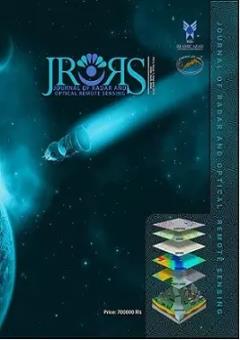Forest road network design based on economic and environmental criteria with weighting the indices using PEGGER software
الموضوعات : فصلنامه علمی پژوهشی سنجش از دور راداری و نوری و سیستم اطلاعات جغرافیاییAmir Hossein Firouzan 1 , Seyed Armin hashemi 2 , Morteza Madani por 3 , Amin Khademi 4 , Hamideh Kavoosi 5 , Shahram Aashkani 6
1 - Department of Forestry ,Lahijan Branch ,Islamic Aza University ,Lahijan ,Iran
2 - Department of Forestry ,Lahijan Branch ,Islamic Aza University ,Lahijan ,Iran
3 - Department of Environment ,Parand Branch ,Islamic Aza University ,Parand ,Iran
4 - Department of Green space ,Malayer Branch ,Islamic Aza University ,Malayer ,Iran
5 - Master of Remote Sensing and Geographic Information System, Iran, Yazd
6 - Department of Forestry ,Lahijan Branch ,Islamic Aza University ,Lahijan ,Iran
الکلمات المفتاحية: Expert Choice software, Forest roads network, Suitable plan,
ملخص المقالة :
Objective: Roads in the forest have several tasks and costly road construction has led the designers to design the best network.
Methods: For this purpose, data layers (slope, direction, forest type, etc.) were prepared and multi-criteria evaluation method of these characteristics was used for preparing suitable plan such that after the classification and valuation of inner layers of maps, Pairwise comparison method in Analytic Hierarchy Process (AHP) was used for weighting the characteristics and a compilation of experts opinions which was designed into questionnaires, entered in the process and using Expert Choice software, the importance coefficient of each layer was obtained.
Results: Weights of factors, characteristics, and restrictions was imported on multi-criteria evaluation model and the combination of characteristics and overlapping the layers according to their importance factor was performed based on multi-criteria evaluation model.
Conclusion: Option 6 were individuated as the most desirable option because of the minimum amount of multiplying the road length in total distance of skidding and the insignificant difference in soil operation volume.
Abdi, O., (2005). Check the network of roads suitable according to the Zagros forest management objectives with the use of GIS and RS (The region field in Khorramabad Lorestan red water). [M.Sc. Thesis, Forestry and Wood Technology Faculty]. Gorgan University of Agricultural Sciences and Natural Resources: 120p.
Abdi, E., Majnounian, B., and Darvishsefat, A., ( 2008). Evaluating Forest Road Net Using Multi Criteria Evaluation in GIS Environment (Case study: Namkhane District). JWSS - Isfahan University of Technology, 12 (44), pp 279-289. DOI: 20.1001.1.24763594.1387.12.44.22.7
Drvish Sefat, A.A., Ahmadi, H., Makhdoom Farkhonde, M., and Abolghasemi, Sh., ( 2005). Routing the road based on the principles of ecosystem using GIS. Iran's natural resources, 60 (1), pp 203-211, https://www.sid.ir/paper/22968
Akay, A.E., Karas, I.R., Session, J., Yuksel, A., Bozali, N., and Gundogan, R.( 2004). Using high-resolution digital elevation model for computer-aided forest road design. Geo-imagery bridging continents. Turkish journal of agriculture and forest. 32 (2), pp 180-188. https://www.semanticscholar.org/paper/USING-HIGH-RESOLUTION-DIGITAL-ELEVATION-MODEL-FOR-Akay-Karas/685cafa7f5cd2890a84836c4116a831c34912618
Chung, W., Sessions J., (2004). An application of a heuristic network algorithm to cable logging layout design. International Journal of Forest Engineering, 15 (1), pp 11–24. DOI:10.1080/14942119.2004.10702485
Heinrich , R., (2001). Recent developments on environmental friendly forest road construction and wood transport in mountainous forest , FAO . Forestry development, Rome, Italy.
Dodson, E., Sessions., J., and Wing, M., (2006). Scheduling forest road maintenance using the analytic hierarchy process and heuristics. J. Silva Fennica 40 (1), PP 143-160. DOI:10.14214/sf.357
Firouzan, A.F., (2007). Forest Road Network Planning Accordance to Single Selection Silvia culture Method Using GIS in Seri 2 Shanderman. [PhD. Thesis], Islamic Azad University Research and Science Branch, Tehran ,145pp.
Hosini, S., (2004), Survey of effective factors on forest road route by using GIS: (case study in kheirud area next to the forest). Iranian Journal of Natural Resources. 57 (1), pp 59-74. https://www.sid.ir/journal/50/fa
Huang, B., Long. C. R., and Liew Y. S., (2003), GIS_AHP model for HAZMAT routing with security considerations. IEEE 6th International Conference on Intelligent Transportation System. Shanghai, IEEE ITS Council: Nov 11–15, pp 1-6
Murthy, A. R., (2003). Selection of least cost paths for extraction of forest produce using remote sensing and GIS. Map India Conference. New Delhi, GIS Development, pp 1–9. https://jfs.agriculturejournals.cz/artkey/jfs-200904-0004_a-gis-mce-based-model-for-forest-road-planning.php
Pentek, T. N., Picman., D., and Porosinsky, T., (2007). Forest road network in the republic of Croatia-Static and perspectivese. Craotion journal of forest engineering, 28 (1), pp 27-37. https://hrcak.srce.hr/11557
Raafatnia, N., Abdi, O., and Shataee, Sh., (2006). Determining proper method of preliminary forecasting of mountain and forest roads using GIS. Iranian Journal of Forest and Poplar Research. 14 (3). Pp 244-257. https://ijfpr.areeo.ac.ir/article_108315.html
Rogres, W.L., (2005), Automating Contour Based Route Projection for Preliminary Forestry Road Designs Using GIS.[ M.S. thesis] Washington State University, College of forest Resources.87p.
Sarkhikhani, N., (2001), Logging in Forest. University Tehran Publication. 727 p.
Sepahvand, A., (2003). Investigation various options to complete road network multipurpose forestry in a series Patom).[ M.Sc. Thesis] Natural Resources Faculty. Tehran University.135p.
Rackely, J. and Chung. W., (2008). Incorporating forest road erosion into forest resource transportation planning; a case study in the Mica Creek Watershed in Northern Idaho, U.S.A. Transactions of ASABE, 51(1), pp 115-127, DOI:10.13031/2013.24232
Dodson, E., Chung, W., Mills, K., Nall, R., Sessions, J., and Zartman. G., (2007). Transportation planning to determine low volume road standards, long-term needs, and environmental risks and tradeoffs. Journal of the Transportation Research Board, 1989 (1), pp 11–19. DOI:10.3141/1989-02
Stückelberger, J., Heinimann, H., and Chung. W., (2007). Improved road network design models with the consideration of various link patterns and road design elements. Canadian Journal of Forest Research, 37(11), pp 2281-2298. DOI:10.1139/X07-036
Aruga, K., Chung, W., Akay, A., Sessions, J., and Miyata, E., (2007). Incorporating soil surface erosion prediction into forest road alignment optimization. International Journal of Forest Engineering, 18 (1), pp 24-32. DOI:10.1080/14942119.2007.10702541
Stückelberger, J., Heinimann, H.R., Chung, W., and Ulber. M., (2006). Automatic road-network planning for multiple objectives. In Proceedings of the 2006 Council on Forest Engineering, July 30-Aug. 2, Coeur d’Alene, ID. pp. 233-248, https://www.semanticscholar.org/paper/Automatic-road-network-planning-for-multiple-*-St%C3%BCckelberger-Heinimann/80fdd52073aeb0070d0632d023ff8774a99d6fd6#extracted


